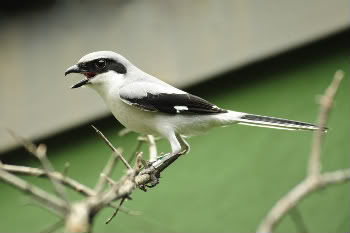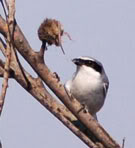The loggerhead shrike, also known as the ‘butcher bird’, employs a feeding strategy that would have been right at home in 15th Century Transylvania. Like the infamous Vlad the Impaler (the brutal prince which Bram Stoker based Dracula off), the loggerhead shrike is truly skilled at impaling. Using its hooked beak to break the spines of insects, lizards, rodents, and even other birds it then impales them on thorns or barbed wire to hold them while it disembodies them.
Now, the Wildlife Conservation Society’s (WCS) Bronx Zoo has brought the loggerhead shrike into its collection, but the shrike is there to illustrate more than its unique feeding practices.
 The terrifying-at least for insects-loggerhead shrike. Photo by: Julie Larsen Maher © WCS. |
Climate change, habitat loss, and pesticides have devastated bird species inhabiting North America’s grasslands like the loggerhead shrike. Populations began declining in the 1950s until today researchers estimate that there are only 100 wild pairs of loggerhead shrikes on the whole continent. The species has been classified as Critically Endangered in Canada, though it has yet to receive any endangered status in the United States. A subspecies endemic to San Clemente Island in California is protected in the US.
 Loggerhead shrike impales mouse on a branch. Photo by: Kathy Radomski, USFWS. |
To aid in the species’ conservation, WCS has joined with the Wildlife Preservation Trust Canada, which is leading a captive breeding program to bring back the imperiled bird. The Canadian group is also conducting surveys in the wild and working with landowners to protect the shrike’s dwindling habitat.
“The exhibit was intended to bring attention to an endangered species that is losing ground as a result of habitat changes,” says Nancy Clum, Assistant Curator of Ornithology for the Wildlife Conservation Society. “Canada has a reintroduction program for this species and we are hopeful that there may eventually be a similar program on this side of the border.”
Despite its fierce feeding practices, the loggerhead shrike doesn’t look menacing: it’s an attractive little songbird with gray and black markings, including a black mask across its face. It possess incredible vision—it can focus on a grasshopper 45-64 meters (150-210 feet) away—which it uses as it watches for prey on a perch.
The Bronx Zoo has recreated the shrike’s grassland habitat, including thorn bushes and a barbed wire fence, so the bird can continue to impale as it would in the wild.
Related articles
Birdwatching contributes $36 billion annually to U.S. economy
(07/15/2009) One fifth of Americans are birdwatchers, according to a report released today by the U.S. Fish and Wildlife Service.
Hawaii continues to stand-by as sheep destroy critically-endangered palila bird’s habitat
(03/25/2009) The environmental legal organization, Earthjustice, has filed legal papers against the Hawaii State Department of Land and Natural Resources for failing to keep feral sheep and goats out of the critically-endangered palila bird’s last habitat. According to Earthjustice, the court has already issued three orders beginning in 1979 that found the state of Hawiai in violation of the Endangered Species Act by not protecting the palila bird from the destructive feeding practices of sheep and goats.
One third of US birds endangered
(03/19/2009) Ken Salazar, the nation’s new Secretary of the Interior, today released the first comprehensive report on bird populations in the United States. The findings are not encouraging: nearly one third of United States’ 800 bird species are endangered with even once common species showing precipitous declines. Habitat loss and invasive species are blamed as the largest contributors to bird declines.